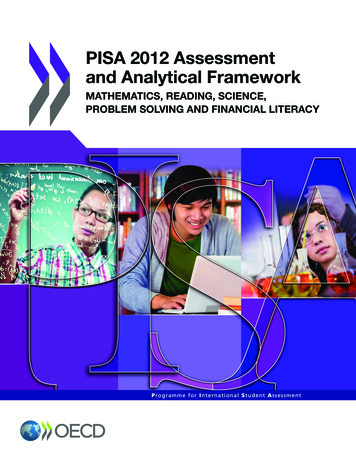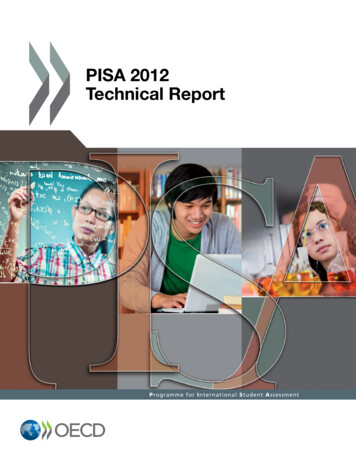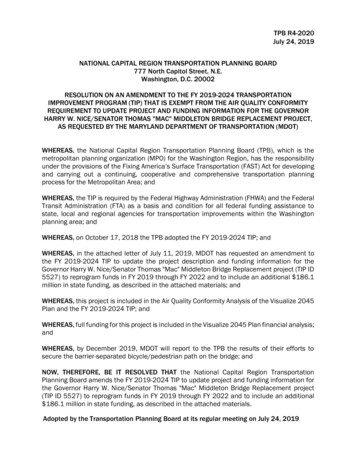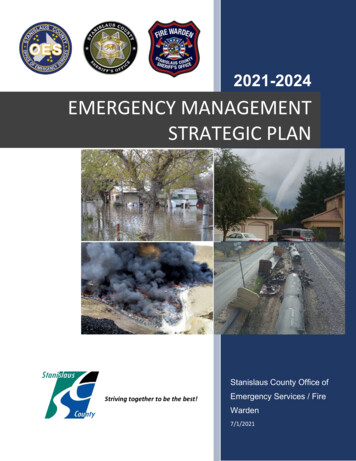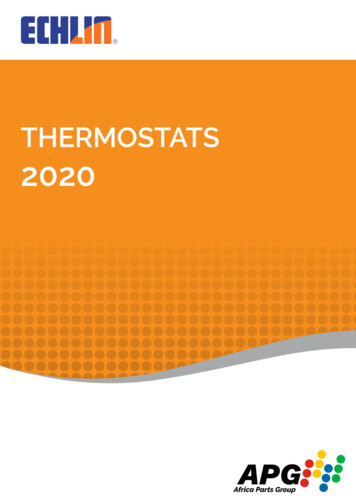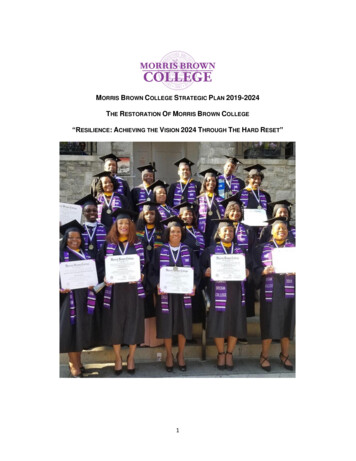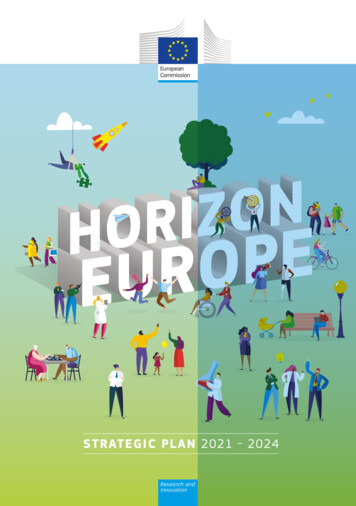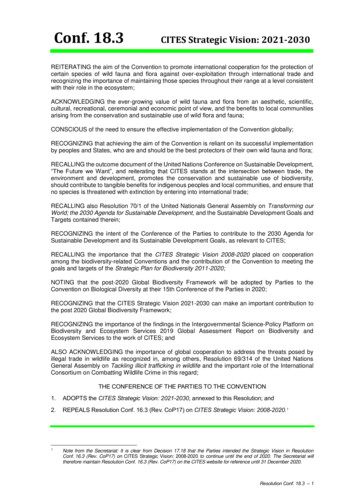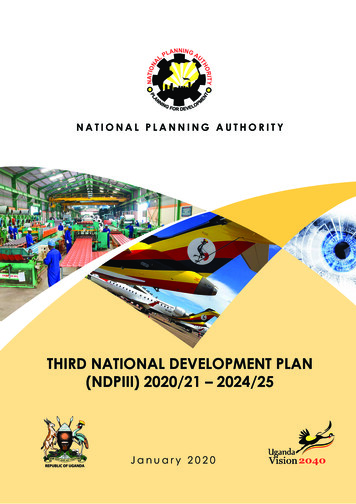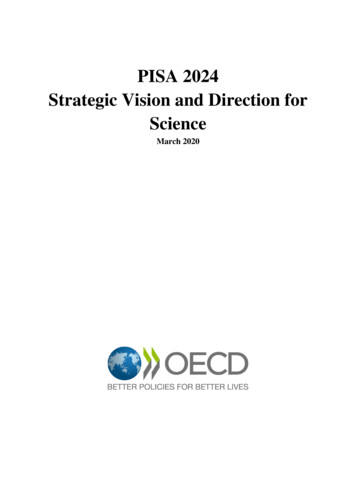
Transcription
PISA 2024Strategic Vision and Direction forScienceMarch 2020
2 PISA 2024 Strategic Vision and Direction for Science:A Vision for What Young People Should Know About Science and be Ableto Do with Science in the Future1.The PISA 2024 Core 2 contract called for a Strategic Visioning Phase (SVP) within theframework development activities to provide a steering document to inform discussion andprioritisation by the Pisa Governing Board (PGB), prior to the Science Framework that will bedeveloped in the next phase by the Science Expert Group (SEG). The methodology used duringthe SVP is described in Appendix 1 and central to the creation of this paper has been theformation of the Strategic Visioning Expert Group (SVEG). The Strategic Visioning ExpertGroup proposes that the PISA Science Framework could be significantly updated through theintroduction of three new content/knowledge areas, two new competencies and a newdimension with sub-dimensions.Context2.Science education has the capacity to help support and equip young people with theknowledge, skills and identities (agency, attitudes, experiences, and personal and socialresources, such as resilience) that will enable them, their communities and societies to tacklemany challenges in the next decades. The extent to which young people are able to criticallyengage with and use scientific knowledge and competencies in their lives beyond the classroomwill be important not only for them personally, but also for the health, fairness and prosperityof societies globally.3.This document sets out a vision for the additional knowledge, competency and identityoutcomes that a young person in 2024 and beyond would be expected to acquire from theirscience learning experiences in order to provide a valuable foundation for future life. The visionis based on the principle that scientific knowledge and competencies are important and valuablefor young people’s futures, but that identity outcomes (and the extent to which young peoplefeel meaningfully connected to science, as critical consumers and producers of science in theirdaily lives) are also crucial for supporting agency and active citizenship in a rapidly changingworld.4.The PISA 2024 vision survey (described in Appendix 1 and 2) demonstrated that thereis a wide, and internationally consistent, awareness of factors in the science domain that willaffect the world that young people emerge into in 10-15 years’ time.5.The SVEG has identified three key dimensions that describe what should be achievedby all 15-year-olds: Scientific Knowledge; Scientific Competencies; and Scientific Identity.The first two dimensions are already part of the PISA Science framework, but the latter is anaddition.PISA 2024 STRATEGIC DIRECTION AND VISION FOR SCIENCE (FINAL DRAFT)
3Scientific knowledgeAdding Three New Knowledge Areas6.The SVEG view is that the scientific knowledge young people will need should bereorganised and updated to better equip them for the world they will live in. Therecommendations are for the creation of three new knowledge areas: ‘Socio-environmental Systems and Sustainability’, to support young people insolving complex, interconnected problems relating to issues which will impact them.This area will include some knowledge previously encompassed withinthedisciplinary subject areas. ‘The Development of Scientific knowledge and its Misuse’, to give students abetter appreciation of how knowledge is developed, and help them navigate theincorrect use of knowledge such as in climate change denial or the anti-vaccinationmovement. ‘Informatics’, to emphasize the importance of the study of data, and the structureand behaviour of information processing systems, both for their impact on societythrough digital technology, in particular, Artificial Intelligence (AI), and for their rolein helping the advancement of knowledge in all scientific domains throughcomputational models (for example, in genomics).Rationale7.During the visioning process, the SVEG felt it important to consider the knowledgeyoung people will need in the future. The SVEG identified a need to reconsider both the contentand its organisation in order to better suit the future needs and the aspirations of young people.The current organisation of knowledge within PISA Science is mostly based on a verytraditional disciplinary framework, and lacks the cross-cutting, contextual, andinterdisciplinary approaches necessary to help in the understanding and solving of problems.Furthermore, although contemporary challenges demand the use of scientific knowledge in abroader context (Erduran and Dagher, 2014), current approaches to the teaching of science donot show how scientific knowledge develops over time.8.The SVEG considered the existing areas and felt that there was a need to expand theareas of knowledge to place more emphasis on the cross-disciplinary nature of science. It wasalso thought necessary to recognize the fact that science is used within a social andenvironmental context that involves consideration of economics, social behaviour, and ethics.Hence the SVEG proposes to add a new knowledge area in order to address what are perceivedto be deficiencies in the light of the current challenges faced by humanity – “SocioEnvironmental Systems and Sustainability”. It was felt that this would better represent thecomplexity and interconnection of problems young people will face in their lifetime, such asclimate change, pandemics, food security.9.Young people need to be critical consumers of scientific knowledge in an era where itis so readily accessible and where arguments may be based on unreliable or questionablescience. They must have some understanding of the way in which science develops reliableknowledge through historical or contemporary examples. Such insight can potentially helpPISA 2024 STRATEGIC DIRECTION AND VISION FOR SCIENCE (FINAL DRAFT)
4 students scrutinise the misuse of science in contemporary themes such as climate change denial,pseudoscience and fake news.10.Rapid advancements in computer-based systems and automation, as well as theavailability of huge sets of digital data are having a notable impact on our societies andeconomies, and have transformed how scientific knowledge is acquired and used. Having beendesigned on scientific concepts, theories, principles, and methods, these technologies willcontinue to improve our knowledge of the world, while becoming an ever-present part of youngpeople’s personal and professional lives. Fluency in the study, interpretation and usage of data,and the structure and behaviour of digital systems carrying out automated processings ofrepresentations will provide young people with a good foundation for their future in anincreasingly digital world.Socio-Environmental Systems and Sustainability11.Science is a powerful tool that humans possess for understanding the material world.Once we understand problems, science gives us ways to solve them, for the benefit of all. TheSVEG believes that an approach to defining content knowledge that focuses on people, theirneeds and interactions with the natural and physical worlds, rather than the internal organisationof scientific facts, is desirable because such an approach will resonate more strongly withyoung people who seek to see the relevance of science to their lives. Solving real-worldscientific problems requires interdisciplinary approaches and methods that focus on the systemand its social, environmental and physical interactions (Clark and Dickson, 2003).Accordingly, the SVEG suggests the addition of a new integrated area of knowledge and arearrangement of those pre-existing areas in the 2015 Framework, to be called: Systems andSustainability.12.The growing recognition that understanding and acting upon many of the problems theworld faces today cannot happen from a disciplinary perspective has fostered the emergenceof new areas of knowledge that integrate across the natural, social and engineering sciences(Clark and Dickson, 2003; Kates et al. 2001). These include, for example, SustainabilityScience, Complex Systems and Political Ecology. Many of these new areas seek also tointegrate with the practical world by intentionally and actively seeking to solve problems byco-creating knowledge with practitioners, stakeholders and policy-makers. Early introductionand exposure of students to these new ways of thinking and acting to solve socio-environmentalproblems such as climate change, pandemics, water security and conservation of species isparamount to prepare them for an uncertain future that can critically shape their well-being.Such systems could include: Economics, markets, institutions Population, migration, well-being Ecosystems, natural resources, conservation Climate change, mitigation and adaptation Sustainable food systems, nutrition, food security Health, environmental health, pollution and spread of disease Land use and change Water, governance and water security Energy supply, development of renewables, and retirement of carbon-based energyresources.PISA 2024 STRATEGIC DIRECTION AND VISION FOR SCIENCE (FINAL DRAFT)
513.Such knowledge would equip young people with the ability to identify elements of acomplex system and to recognise the interactions within a system, as well as between systems.For instance, the reintroduction of wolves into any ecosystem has consequences for the localenvironment that includes the plants, trees and flow of water in the system. To fully evaluatesuch initiatives requires asking broader questions than just what might be the immediate impacton farmers or the deer population, for example.The Development of Scientific Knowledge and its Misuse14.Young people should have some appreciation of the intellectual achievement that ourcontemporary scientific understanding represents. This applies not only to knowledge forwhich there is current consensus (e.g. structure of DNA) but the errors and flaws that have beenmade in the past – for instance, the geocentric world view, Lamarckianism, caloric theory, coldfusion, eugenics. If one of the goals of science is to ‘teach how science works’ (OECD, 2009),then it is equally important to teach students how science does not work (Allchin, 2012).Studying science in a historical or contemporary context exposes how scientific knowledgedevelops and the community practices (e.g. peer review) and criteria (e.g. objectivity) thatenable it to establish reliable knowledge (Matthews, 2015). The inclusion of some selected casestudies from science’s history (including the recent history of science) can help studentsidentify the flaws in the scientific arguments of those who wish to discredit the use ofvaccination, deny the existence of anthropogenic climate change or argue for a creationistworldview.15.Another important issue from recent history of science is the commercialisation ofscientific knowledge in the context of new domains such as gene technology (Erduran andMugaloglu, 2013). Technology and innovation are paving the way for new profit opportunitiesaround scientific knowledge. Scientific knowledge is increasingly commodified within ascience market that treats information as private property. Commodification of scientificknowledge may potentially hinder free consumption of scientific knowledge by the public(including teachers and students) or rival producers of scientific knowledge among scientists.Trends in the commercialisation of scientific knowledge point to the need to equip studentswith understanding of how economic and political factors may influence decision-makingabout scientific knowledge (e.g. patenting of genes).InformaticsInformatics is the study of the data, structure, and behaviour of natural andcomputational systems. The SVEG is proposing Informatics is considered for inclusion withinthe Science Framework, either as an additional knowledge area, or integrated within theexisting and proposed additional knowledge areas.16.17.Artificial Intelligence (AI) and machine learning are branches of informatics that arehaving a significant impact on our societies and economies. The fundamentals of AI are basedon designing systems which mimic or emulate systems found in nature, and a basic knowledgeof natural data structures and systems is therefore beneficial in developing a conceptualunderstanding of how AI works and can be developed.18.Besides its applications in AI development, informatics also plays an important role inacquiring and using knowledge across the scientific disciplines. Biological and health sciences,in particular, have seen rapid advancement in recent years, with bioinformatics and genomicsnow holding the key to solving many of the world’s problems. In the future, when personalisedmedicine will become standard practice, all healthcare practitioners and indeed patients willPISA 2024 STRATEGIC DIRECTION AND VISION FOR SCIENCE (FINAL DRAFT)
6 need to possess the knowledge and competencies to decode the information obtained viagenome sequencing and testing.19.With this in mind, the SVEG believes that every young person should be digitally anddata literate at age 15. This includes being familiar with different models for the representationof data, basic computational models and algorithms, as well as any additional areas ofprocedural knowledge resulting from ‘dry lab experiments’ (involving large data sets andinformation structures). Moreover, being digitally and data literate would enable young peopleto understand AI concepts and computational systems at a basic level in order to makeimportant decisions about how to act on information presented to them. It would also supportthem in functioning and succeeding in transformed workplaces, allowing them to be activeparticipants in the digital world. Ultimately, such knowledge will support young people tounderstand, use, participate in, influence, and contribute to the development of both the digitalworld and a fair, just and safe digital society (Caspersen et al. 2019; Nardelli 2019).20.Appendix 3 further defines the discipline of informatics, and the knowledge andcompetencies it comprises. It also explains how this new domain is different fromcomputational thinking (as defined in the PISA Mathematics Framework).PISA 2024 STRATEGIC DIRECTION AND VISION FOR SCIENCE (FINAL DRAFT)
7Scientific CompetenciesAdding Two New Competencies and Developing Two Existing Competencies21.Given the technological advancements over the past decade, the scientificcompetencies required by young people to thrive in society will need to be further developed.22.The view of the SVEG is that two new competencies should be developed, and twoexisting competencies expanded. The two new competencies are: Using scientific knowledge for decision-making and action, as young people needthe capacity to actively use their scientific knowledge to decide on courses of action,and to create new value. These decisions need to be made in complex systems, takinginto account economic, political, and ethical considerations. Using probabilistic thinking, as understanding probability and risk are central tomost scientific issues and essential for informed decision-making.The two competencies to be expanded are: Evaluating and designing scientific enquiry, to add the ability to researchinformation and design enquiry within complex systems. Interpreting data and evidence scientifically, to add the ability to interrogate largedata sets, as well as the ability to use scientific judgements for decision- making.Rationale23.Science education is playing an increasingly important role in providing young peoplewith the crucial thinking tools needed to navigate a non-stop world characterised byinformation deluge, new physical technologies and new AI capabilities. How thesecharacteristics will impact the world in the future is yet to be determined, but science, throughits specific methods and culture, can equip young people with the competencies needed tocritically examine them and responsibly engage with what they offer.24.The PISA 2015 Science framework already identified three key competencies, and it isthe view of the SVEG that the existing competencies (explaining phenomena scientifically;evaluating and designing scientific enquiry; interpreting data and evidence scientifically) needto be both extended and complemented by new ones, especially as new technologies haveplayed increasingly visible roles in our societies’ deliberation and decision-making.25.The two new competencies that need to be added are: Using scientific knowledge for decision-making and action, as most of the dilemmasthat will confront individuals in their personal and professional lives can be informedto some degree by scientific findings. Using probabilistic thinking, as understanding probability and risk is a central featureof most scientific issues confronting citizens in today’s society.PISA 2024 STRATEGIC DIRECTION AND VISION FOR SCIENCE (FINAL DRAFT)
8 Using scientific knowledge for decision-making and action26.The SVEG recognizes that scientific knowledge has an intrinsic value for understandingthe material world in which we live and is of the view that young people in the future shouldbe able to:Use scientific knowledge for decision-making27.One of the major goals of science is to produce findings that can inform and improveaction. Most of the dilemmas that confront individuals in their personal and professional livescan be informed to some degree by scientific findings. Appreciating how science hascontributed – and can contribute – to the improvement of health, energy and food supply, andadaptability to climate change are all important outcomes for any science education. Morebroadly, developing the ability to investigate how science might inform an issue, whetherpersonal, local or global, and asking appropriate questions, will help young people to see therelevance and salience of science.28.Thus young people need to be able to consider the different mechanisms that result inparticular events and the extent to which these are caused by scientific, social, economic andpolitical dimensions (Levinson, 2018). By explaining the world using this interdisciplinaryapproach young people are better able to operate within complex systems, to identify the bestsolutions to problems by evaluating their relative strengths and weaknesses, and to evaluatedifferent courses of action on the basis of ethical and economic advantages anddisadvantages. Moreover, they are also better able to identify the physical, ecological andsocio-political feedback mechanisms and behaviours that occur because of the connectionswithin a system.Take into account ethical considerations29.Advancements in technology, in particular artificial intelligence and biotechnology, addlayers of complexity to decision-making. Science education plays a key role in ensuring youngpeople are equipped to apply ethical reasoning in relation to science, to consider consequencesand evaluate externality in relation to experimental design and problem analysis. They will alsoneed to accept that science does not give direct answers for decision-making or about ‘whatone should do’, but requires an ethical and value-driven component that is strongly linked withissues of identity and inequalities. Finally, young people will need to ask themselves if theiractions, or actions of others who they enable or support, are ethical and in-line with their values,and apply this thinking and their values consistently in their everyday lives.Create new value through problem-solving and innovation30.Science education needs not only to equip young people with decision-makingcompetencies to navigate life, but also to empower and support them to develop competenciesinvolved in taking action and ‘creating new value’. This transformative competency is essentialfor acting towards improving our society. When young people create new value, they askquestions, collaborate, and try to ‘think outside the box’. They approach problems using a rangeof strategies, reflect on what has and has not worked, and have the resilience and agility to tryagain in search of a solution. In doing so they can become more prepared and resilient whenconfronted with uncertainty and change.PISA 2024 STRATEGIC DIRECTION AND VISION FOR SCIENCE (FINAL DRAFT)
931.Problem-solving and innovation are fundamental features of science yet, too often,these do not feature in a young person’s experience of science at school. When young people’sdecision-making and agency are encouraged, more positive attitudes towards science andstronger identification with science are supported.Using probabilistic thinking32.The SVEG is of the view that understanding probability, uncertainty, and risk is acentral feature of most scientific issues confronting us all, young and old (Bennet and Calman,2000; Adams, 1995). It is, for instance, central to understanding how to respond both personallyand as a society to the challenges posed by global health emergencies, such as a pandemic. Atthe core of all risk judgments is an understanding of probability, normal and abnormaldistributions and the meaning of common ways of expressing uncertainty, so young people inthe future will need to be able to:Recognize and utilize the power of probabilistic assertions, a key element of scientific culture33.Scientists treat essentially every proposition and every statement of possible fact withsome degree of tentativeness, whether 51% confidence (only just more likely to be true thanfalse) or 99.9999% confidence (high certainty to be true). Using this pervasive probabilisticthinking approach makes it possible for scientists to be more comfortable with being wrong,on the one hand, and with changing their position with respect to new evidence, on the other.Young people should be able recognise this usage as a source of science’s strength, not anindication of weakness. They should also be able to estimate the confidence level associatedwith their own statements in an argumentation or discussion.Interpret levels of confidence in a claim34.All scientific measurements have some errors associated with them. Thus, the simplebinary distinction of true/not true is not valid when dealing with complex, multivariate systems.Young people should be able to estimate what fraction of scientific papers that make a claimwith 95% confidence could turn out to be wrong. For instance, they should understand whythey should treat one newspaper article about health-related issues with a degree of scepticism,and understand that progress in knowledge is built through an accumulation of similar findingswhich gradually increase our confidence and certainty. More generally, they should be able torecognise the limitations of scientific inquiry and apply critical thinking when engaging withits results.Recognise that all activities have risk associated with them, and be able to interpret riskstatistics and their implications35.Furthermore, all activities have risks associated with them. Risk statistics commonlyonly measure fatalities and not injuries and the decision to take risks is different depending onwhether it is an individual risk, a population risk, a system risk or a lifetime versus immediaterisk. Students need to understand that risk is an inherent feature of life and not something to beavoided.Recognize the common forms of representing population statistics, their use and misuse36.Students need to understand the concept of a normal distribution and the differencebetween a mean and a median. They should also understand that confidence is commonlyPISA 2024 STRATEGIC DIRECTION AND VISION FOR SCIENCE (FINAL DRAFT)
10 expressed with the use of an error bar, and that within any population there will be variabilityand outliers. Using this knowledge, they should be able to make evaluative judgements ofstatistical data asking, for instance, what meaning can be attached to the outliers. For instance,they should be able to distinguish between cause and correlation and be aware that within anylarge data set there is a high chance of seeing what appear to be significant effects. The latteris particularly important given the increasing use of large data sets and the possibility formisinterpretation or bias due to the nature of the underlying data. Students should be able tosay that if two data points are within each other’s error bars they represent effectively the samelevel, even if one is apparently higher than the other; and therefore it is impossible to comparetwo data points if their error bars are not given.Make predictions37.Increasingly students will be living in a world where large data sets and machinelearning algorithms are used to make predictions. Students need to be able to interrogate thepredictions or findings made by such AI systems by asking whether the data set used is biased,and by questioning the size of the data set on which it is based and the level of confidence thatcan be placed in the predictions.38.The two existing competencies to which additions are suggested are: Evaluating and designing scientific enquiry Interpreting data and evidence scientifically.Additions to the competency of “Evaluating and designing scientific enquiry”39.The SVEG also considered the existing competency of “Evaluating and designingscientific enquiry” and felt that it needed to be expanded to include two additional elements.Understanding design in complex systems40.Observing and understanding systems, at both a micro and a macro level, allows foridentification of emerging phenomena, physical reactions and behaviours. Understandingcomplexity allows for identification of emerging properties that can sometimes only becomeapparent when moving between a system’s levels.41.By being able to understand design in complex systems, young people will be able to: Identify the elements of a complex system Recognise what component subsystems are and how they interact with each other(sources and sinks; feedback loops; levels of organisation) Predict the impact of action within a system Predict the impact of action of a system on another Make risk assessments within the context of a system.Researching and evaluating information42.All enquiry begins on a base of existing knowledge. Increasingly such knowledge isprovided by search engines. Thus, young people need to be able to evaluate scientific searchesin a critical manner by recognizing potential biases and unreliable sources or untrustworthyresources (Breakstone, J., et al. 2018). For instance, young people should:PISA 2024 STRATEGIC DIRECTION AND VISION FOR SCIENCE (FINAL DRAFT)
11 recognize that multiple searches may be necessary using different terms and requiringthem to then identify the best and most relevant resources to their inquiry. look for evidence that there was some consideration of the ways that the findings maybe flawed or limited and/or evidence of an understanding of the complexities of thetopic. make evaluative judgements about the expertise of the source.To do this, young people will need to be able to identify the essential elements of anargument distinguishing between a claim, its supporting evidence and the reasoning thatsupports the argument. They should be aware of the issue of confirmation bias and look to seewhether counter arguments have been considered and addressed and use this information tohelp them make evaluative judgements of the quality of the scientific work and the validity ofthe claims. Key tests would be whether they can identify pseudo science, fraudulent scienceand poorly done science from good science that happens to get the wrong answer.43.Additions to the competency of “Interpreting data and evidence scientifically”44.Technological tools increasingly offer young people the ability to interrogate large datasets. Young people need to be able to distinguish between the value of searches which are basedon scientific hypotheses and activities which are essentially looking for patterns providing arationale for the search they are undertaking. They should be alert to the fact that in most largedata sets such patterns may be the product of randomness, spurious correlations. Only rarelydo the patterns reveal an underlying causal relationship which needs to be advanced (Calude,C.S. et al. 2017).45.Young people need to have the competency to use basic data tools which enable theinterrogation of such data sets and generate meaningful representations of the data in standardforms such as histograms, graphs or stem and leaf plots.46.In addition, an important element of evaluating data is the ability to make order ofmagnitude estimates of quantities to see if a finding fits within the bounds of rational, commonsense possibility. Such data is used to make judgements and contributes to the new competencyof using scientific knowledge for decision-making and action. Hence the existing competencymight be more aptly renamed as “Interpreting data and evidence to make judgements”PISA 2024 STRATEGIC DIRECTION AND VISION FOR SCIENCE (FINAL DRAFT)
12 Scientific Identity - a New Dimension in the PISA assessmentAdding a new dimension to the PISA Science Framework47.It is the view of the SVEG that identity is a key factor shaping the extent to whichscientific knowledge and competencies can be both achieved and realised. Identity mediateslearning and understanding – if we fail to pay attention to a young person’s scientific identityoutcomes then we undermine the achievement and potential of scientific learning and theextent to which young people will be able to critically use and act with these competenciesin life. Identity outcomes are integrally tied to social justice and are key considerations whenworking towards more equitable science cultures and practices. Key scientific identityoutcomes include young people achieving a meaningful connection with science, feeling thatscience is ‘for me’, finding
Group proposes that the PISA Science Framework could be significantly updated through the introduction of three new content/knowledge areas, two new competencies and a new dimension with sub-dimensions. Context 2. Science education has the capacity to help support and equip young people with the
